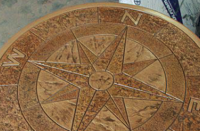QC Construction Products found gold at the end of the rainbow. In other words, color meant opportunity.
Started in 1992 in Madera, Calif., QC Construction began life as a regional supplier of decorative concrete raw materials — colors, hardeners, release powders — to contractors in central and southern California. The company blossomed in the mid-’90s when contractors and homeowners alike discovered that there was more to concrete than mere shades of gray.
 “The growth of decorative concrete during the mid-’90s was huge,” says QC’s national technical director, Chris Sullivan. “QC went from being a small, regional player servicing a few-hundred-mile radius from the plant in Madera to where we are now, a national player with five regional sales managers and 30 sales reps all across the country.”
“The growth of decorative concrete during the mid-’90s was huge,” says QC’s national technical director, Chris Sullivan. “QC went from being a small, regional player servicing a few-hundred-mile radius from the plant in Madera to where we are now, a national player with five regional sales managers and 30 sales reps all across the country.”
Sullivan attributes the phenomenal growth in sales to a few key factors. First of all, the design community vigorously embraced the product line being offered by QC. Suddenly, it seemed, everyone wanted concrete in different colors. A variety of integral colors and stains were clearly the way to go, particularly in style-conscious California. It was only a matter of time before the rest of the country followed suit.
 “Number two, contractors and applicators were seeing the increase in the amount of money they could make,” Sullivan says.
“Number two, contractors and applicators were seeing the increase in the amount of money they could make,” Sullivan says.
And finally, he says, homeowners climbed aboard this colorful bandwagon. “I would say a large portion of (the sales) came from residential use — patios, driveways, walkways. And we’re seeing more decorative concrete use in interiors as well. HGTV is huge at getting people introduced at the homeowner level. We get so many calls from people saying they want this or that kind of stain that they saw on HGTV for their patio.”
 When it became apparent that the demand for color was going to be a market force to be reckoned with, the brain trust at QC faced a critical decision: quality versus quantity.
When it became apparent that the demand for color was going to be a market force to be reckoned with, the brain trust at QC faced a critical decision: quality versus quantity.
“We are not a commodity-driven line,” Sullivan says. “I think one of the challenges we faced on the way up was whether or not we were going to try and be all things to all people. There are companies out there that treat these products like commodities, available on every street corner. We want to deal with the upper-end, leading distributors in the market, and we want to have cutting-edge product quality. We aren’t trying to sell everybody, just the people who are striving to do the highest quality work.”
Sullivan and his QC compatriots found that they got great feedback by getting the stains and colors into the hands of applicators doing the most creative work. “They’re doing things with our products that we never thought of,” he says.
As for the products themselves, many have contributed to QC’s rise in popularity. In addition to QC Patina Stain and ColorTech E, which have been used on high-profile jobs at the Luxor in Las Vegas and Disney World in Orlando, Sullivan is especially keen on another development.
“We have a product, that to my knowledge, nobody out there has anything quite like it,” he says. “It’s a penetrating reactive stain, but it’s water-based. It’s called QC CemTint and it’s a water/lithium-based reactive stain. It works on different chemistries and different properties than acid stains.
 “Acid stains are available in basically eight colors. CemTint is derived from a proprietary blend of reactive, UV-stable chemicals. You can now get any tint under the sun — purples, blues, shades of green. The palette is now endless. There are other companies that have what they call water-based stains, but nothing that is actually a true reactive or penetrating stain like this product.”
“Acid stains are available in basically eight colors. CemTint is derived from a proprietary blend of reactive, UV-stable chemicals. You can now get any tint under the sun — purples, blues, shades of green. The palette is now endless. There are other companies that have what they call water-based stains, but nothing that is actually a true reactive or penetrating stain like this product.”
 Sullivan also proudly points to a new one-part modified epoxy called QC Perma Seal. “It’s had great results in durability, both inside and outside, and it’s a simple application. It’s good for people imprinting concrete outside who want more of a matte or satin look. It’s also excellent for people working inside with stain or overlay who are looking for durability but who don’t have the time to wait for a two-part urethane to cure out. You can walk on this product in about an hour.”
Sullivan also proudly points to a new one-part modified epoxy called QC Perma Seal. “It’s had great results in durability, both inside and outside, and it’s a simple application. It’s good for people imprinting concrete outside who want more of a matte or satin look. It’s also excellent for people working inside with stain or overlay who are looking for durability but who don’t have the time to wait for a two-part urethane to cure out. You can walk on this product in about an hour.”
QC also has new sealers and overlay products in various stages of production. Sealers in particular, Sullivan says, continue to create a lot of questions for applicators. QC’s solution was to create an entire operating system for its distributors.
 “We target training and education with our products and getting the word out to the applicators through our distribution network,” Sullivan says. “We have a training program called the QC Color Tour that travels around the country to our big distributors and offers either free or low-cost training with our products. It’s a whole system from nuts to bolts: service, training and backup within a product family.
“We target training and education with our products and getting the word out to the applicators through our distribution network,” Sullivan says. “We have a training program called the QC Color Tour that travels around the country to our big distributors and offers either free or low-cost training with our products. It’s a whole system from nuts to bolts: service, training and backup within a product family.
“Take acid staining for example: We have all the products from beginning to end. We have the prep products, the cleaners, the stains. We have the neutralizing and washing products. We have the base-coat sealers, the finish and maintenance sealers. We have accessory products and additives. And we’ll show you how to use them.”
 Apparently, QC made all the right moves at crunch time. The company is enjoying considerable growth and currently has about 60 employees. QC also recently opened a second plant in Knoxville, Tenn., to service the expanding Northeast market.
Apparently, QC made all the right moves at crunch time. The company is enjoying considerable growth and currently has about 60 employees. QC also recently opened a second plant in Knoxville, Tenn., to service the expanding Northeast market.
“These trends tend to go from west to east,” Sullivan says. “Decorative concrete, while it continues to grow nicely everywhere, is getting hot on the East Coast. It’s a huge market with huge potential. I expect substantial growth in the next five to 10 years.”
Sullivan says that he sees more and more concrete contractors everywhere looking for training in decorative applications.
 “I’ve been in this industry for about 12 years,” he says. “When I first started, there were a lot of applicators and ready-mix suppliers who wanted nothing to do with color. It was a pain, it was a bother, it was messy. Now, because of financial gain, sales and demand, we’re seeing very few places where that attitude prevails.
“I’ve been in this industry for about 12 years,” he says. “When I first started, there were a lot of applicators and ready-mix suppliers who wanted nothing to do with color. It was a pain, it was a bother, it was messy. Now, because of financial gain, sales and demand, we’re seeing very few places where that attitude prevails.
“We’re finding more and more applicators are becoming savvy to the products and actually becoming artisans.”














